Heavy-Duty Blacksmith Hammers for All Projects
Abana Chapter
February 11, 2024
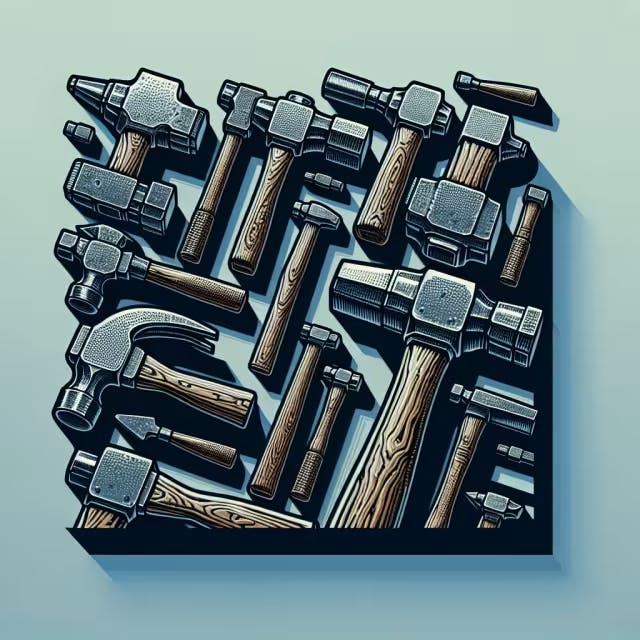
Embarking on blacksmithing projects requires not just skill and creativity but also the right tools, of which, the heavy-duty blacksmith hammer is indispensable. Whether you're shaping metal into intricate designs for gates, crafting durable tools, or forging unique pieces of furniture, understanding the pivotal role of heavy-duty blacksmith hammers for all projects is key. This article delves into the art and science of choosing the perfect hammer for every blacksmithing task, ensuring your creations are not only beautiful but also structurally sound.
Key Takeaways
Selecting the correct heavy-duty hammer is vital for any blacksmithing project, influencing the ease of work and the quality of the final product.
Familiarity with different types of blacksmith hammers and their specific uses is essential for choosing the right tool for each task.
When choosing a hammer, look for essential features such as durability, balance, handle comfort, and appropriate weight for your specific needs.
Regular maintenance of your blacksmith hammers, including proper storage and handling, can significantly extend their lifespan.
For purchasing quality blacksmith hammers, research reputable suppliers in the United States that specialize in blacksmithing tools.
Understanding the role and importance of heavy-duty blacksmith hammers enhances not only the efficiency of the work but also contributes to the creation of both beautiful and structurally sound projects.
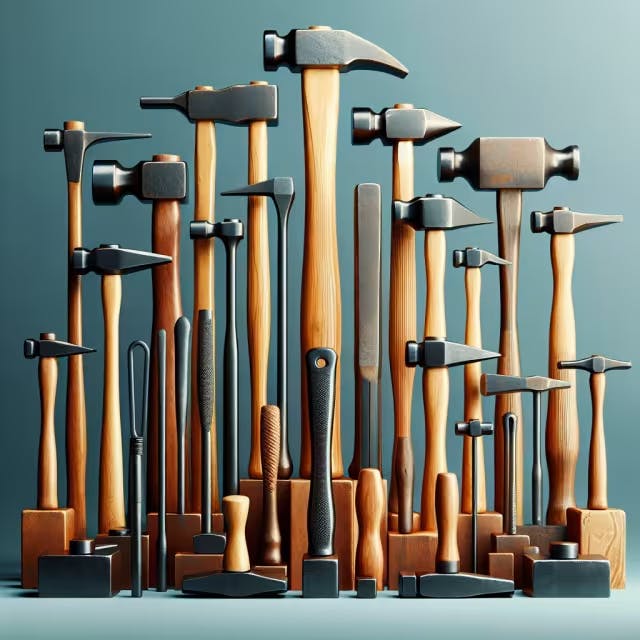
Choosing the Right Heavy-Duty Hammer for Blacksmithing
When embarking on blacksmithing projects, the quality and type of hammer you choose can significantly impact your work's efficiency and outcome. Different types of hammers serve various purposes, from shaping metal to chiseling. Here’s a brief guide to help you select the appropriate heavy-duty hammer for your blacksmithing needs.
Cross Peen Hammer: Ideal for starting taper on square stock. The peen (the part of the head) allows for more controlled spreading of the metal.
Straight Peen Hammer: Similar to the cross peen but with a peen parallel to the handle. It's excellent for elongating the metal in specific directions.
Rounding Hammer: Features a rounded face that helps in moving metal in a more controlled manner than flat hammers. It’s perfect for freeform shaping and smoothing.
Choosing a hammer with the right weight is also crucial, as it directly affects your control over the workpiece and your fatigue levels. A hammer too heavy might lead to quick exhaustion, while too light a hammer may not provide adequate force.
Weight Guide:
Hammer Type | Suggested Weight |
Cross Peen | 1.5 - 2.5 lbs |
Straight Peen | 1.5 - 2.5 lbs |
Rounding Hammer | 2 - 4 lbs |
Remember, the best hammer is the one that feels right in your hand and suits your project's specific needs. For a comprehensive guide on blacksmith hammers and to find the perfect hammer for your next project, check out this detailed article here. Whether you're a beginner or a seasoned blacksmith, having the right hammer can make all the difference in your craft.
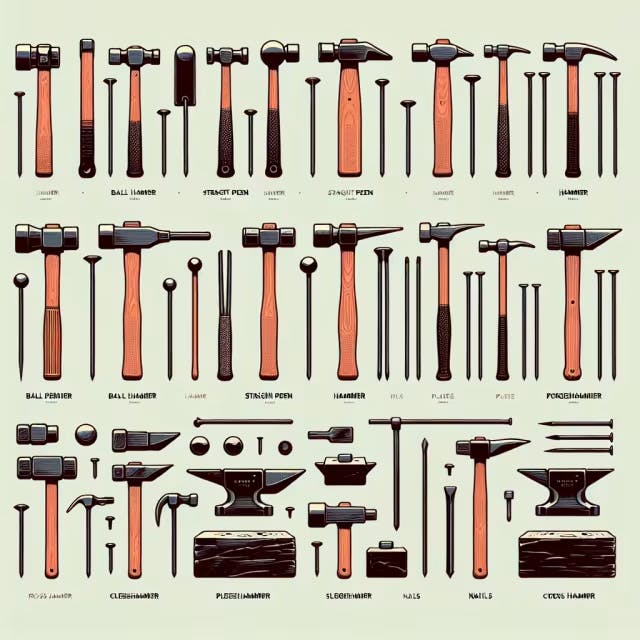
The Ultimate Guide to Blacksmith Hammer Types and Uses
Choosing the right hammer for your blacksmithing projects can significantly impact the quality and efficiency of your work. Here's a brief rundown of the most commonly used heavy-duty hammers in blacksmithing and their specific uses.
Cross Peen Hammer: Ideal for starting spreads and drawing out metal, the wedge-shaped end perpendicular to the handle is perfect for tight spaces and detailed work.
Straight Peen Hammer: Similar to the cross peen, but with the wedge parallel to the handle, it excels in creating textures and working metal in a specific direction.
Sledgehammer: A heavyweight champion for moving large amounts of metal quickly. It's often used in pairs with one blacksmith striking and another holding the workpiece.
Ball Peen Hammer: Known for its rounded end opposite the flat face, it's mainly used for riveting, metal design, and rounding off edges of metal pins and fasteners.
Rounding Hammer: With one round and one flat face, this versatile tool is excellent for general forging, allowing the smith to move metal efficiently in multiple directions without changing hammers.
Each hammer type brings something unique to the forge, from shaping and texturing to moving large amounts of metal. Understanding the specific purpose and best application of each will enhance your skills and output as a blacksmith. Whether crafting intricate, detailed pieces or working on large-scale projects, having the right heavy-duty hammer in your toolkit is essential for achieving the best results.
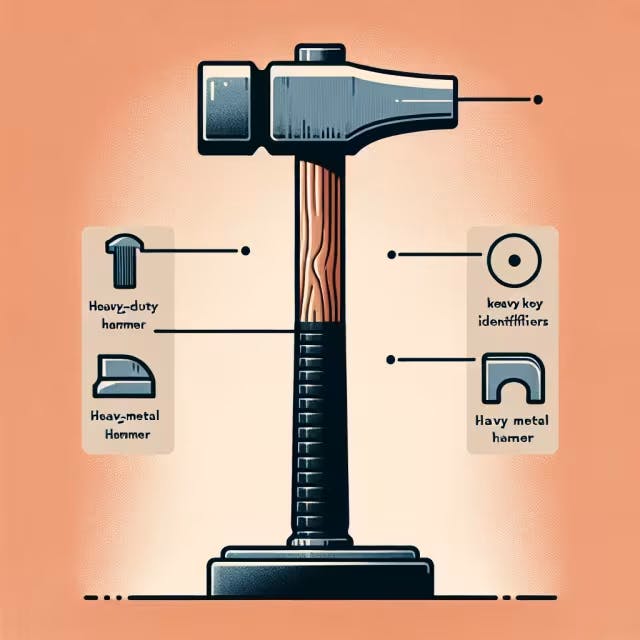
Essential Features to Look for in a Heavy-Duty Blacksmith Hammer
When shopping for heavy-duty blacksmith hammers for all projects, considering the tool's weight, material, and handle length is crucial to finding the right fit for your forging needs.
Weight: A hammer's weight influences its strike force and control. A heavier hammer delivers more force, useful for shaping large, thick materials, but can be tiring to use. Lighter hammers offer more precision and are easier to handle for detailed work.
Material: Most blacksmith hammers are made of high-grade steel for durability and longevity. The material's quality affects the hammer's performance and resistance to wear and tear.
Handle Length: The handle's length affects leverage and control. Longer handles enable stronger strikes but require more space to swing, making them less ideal for confined spaces.
Selecting a hammer with these features suited to your specific project requirements enhances efficiency and safety in the forge. Learn more about the crafting process from expert sources like Wikipedia, which offers insight into the blacksmith's craftsmanship, including the forging and shaping of metal that necessitates the use of a high-quality hammer.
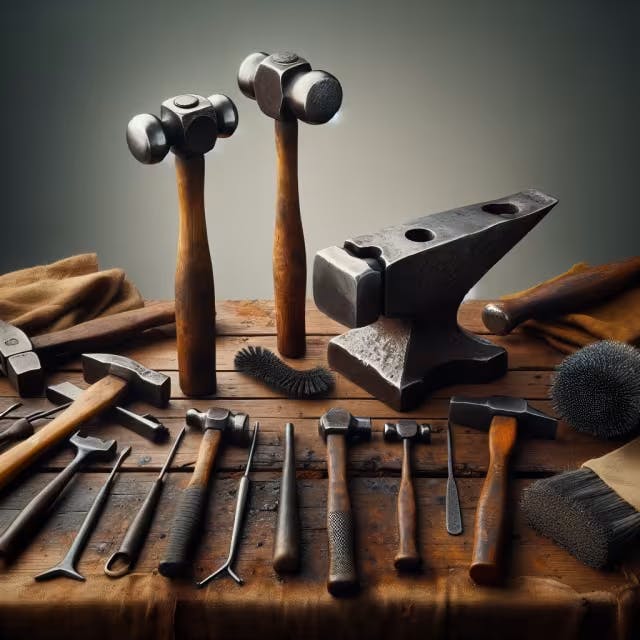
Maintaining Your Blacksmith Hammers for Longevity
To ensure your heavy-duty blacksmith hammers remain in top condition for all projects, here are a few maintenance tips:
Regular Cleaning: After each use, wipe down the hammer to remove any debris or dust. This prevents buildup that could affect its performance.
Proper Storage: Store your hammer in a dry place. Moisture can lead to rust, which weakens the metal over time.
Handle Care: Check the hammer's handle for any cracks or wear. A damaged handle can break during use, posing a safety hazard.
Rust Prevention: If rust starts to form, use fine-grit sandpaper to remove it. Then apply a light coat of oil to protect the metal.
By following these simple steps, your blacksmithing tools will serve you well for many projects to come.
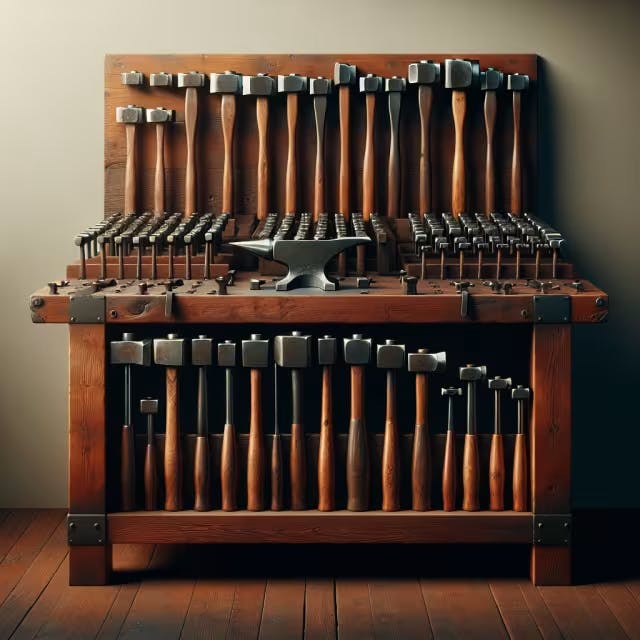
Where to Buy Quality Blacksmith Hammers in the United States
For those passionate about the art of blacksmithing, selecting the right tools is not just necessary; it's central to the craft. Blacksmiths, with their skilled manipulation of wrought iron or steel, shape these materials into various objects through techniques like forging, hammering, bending, and cutting. These methods have evolved from traditional forges to include modern heating like induction but rely heavily on the quality of the blacksmith's hammer.
Finding quality heavy-duty blacksmith hammers in the United States can seem daunting, but with a bit of research, you can find suppliers that cater to all levels of expertise. Consider local artisan shops that may offer handmade hammers tailored for different projects. These shops often provide tools with a touch of personal craftsmanship, invaluable for specific or intricate work. Additionally, online marketplaces and specialty websites dedicate a significant portion of their catalog to blacksmithing tools, including hammers that cater to all project sizes, from intricate jewelry to large wrought iron gates.
When choosing your hammer, remember the specific projects you undertake. The variety of blacksmithing techniques, such as welding, heat-treating, and finishing, require different hammers. Each technique needs a specific type of hammer to achieve the best results, so it’s crucial to match the tool to the job.
For more detailed insights into the craft of blacksmithing and the tools it entails, explore Wikipedia’s informative page on blacksmithing. This resource can deepen your understanding of the techniques and history behind this timeless craft, guiding your decisions on purchasing the best heavy-duty blacksmith hammers for your projects. In conclusion, selecting the right heavy-duty blacksmith hammer is pivotal to achieving efficiency and desired results in any project. By understanding the importance of hammer type, weight, quality, and maintenance, blacksmiths can ensure their tools contribute effectively to their craft. With the right knowledge and quality tools sourced from reputable suppliers in the United States, blacksmiths are well-equipped to shape materials with precision and durability, ensuring their projects stand the test of time.
Frequently Asked Questions
What are the key differences between cross peen, straight peen, and rounding hammers in blacksmithing?
Cross peen, straight peen, and rounding hammers are all essential tools in blacksmithing, each serving a unique purpose. The cross peen hammer is distinguished by its wedge-shaped end perpendicular to the handle, making it ideal for starting spreads and drawing out metal, especially in tight spaces or for detailed work. In contrast, the straight peen hammer has a wedge parallel to the handle, excelling in stretching metal in specific directions and creating textures. The rounding hammer, known for its one rounded and one flat face, offers versatility for general forging, allowing blacksmiths to efficiently move metal in multiple directions without the need to switch hammers. Understanding these differences is critical for selecting the right hammer to match the specific requirements of a project, enhancing both the efficiency and the quality of the work.
How does the weight of a blacksmith hammer impact its use and the blacksmith's fatigue levels?
The weight of a blacksmith hammer significantly impacts its usage and the blacksmith's fatigue levels. A hammer that is too heavy can lead to quick exhaustion, diminishing the blacksmith's efficiency and increasing the risk of injury due to overexertion. Conversely, a hammer that is too light may not provide enough force for effectively shaping the metal, requiring more strikes and potentially leading to longer work times and inconsistent outcomes. Choosing a hammer with an optimal weight enhances control over the workpiece and minimizes fatigue, allowing for precision in metal shaping and prolonging productive work periods. The advised weight ranges for various hammers, such as 1.5-2.5 lbs for Cross Peen and Straight Peen hammers and 2-4 lbs for Rounding Hammers, serve as guidelines to balancing strike force with manageability, directly influencing work quality and craftsman comfort.
Why is the material and handle length important when choosing a heavy-duty blacksmith hammer?
The material and handle length of a heavy-duty blacksmith hammer are crucial for several reasons. A hammer's weight, influenced by its material, directly affects strike force and control; heavier hammers are suitable for shaping larger, thicker materials but can lead to quicker fatigue, whereas lighter hammers offer precision for detailed work. The hammer material, typically high-grade steel, determines the tool's durability and performance, with quality material ensuring longevity and resistance to wear. Handle length impacts leverage and control, where longer handles provide stronger strikes but may be unwieldy in confined spaces, making it essential to select a handle length that balances power with maneuverability according to your project needs. Selecting the right combination of these features optimizes efficiency, safety, and comfort in the forge.
What maintenance tips can extend the life of heavy-duty blacksmith hammers?
To prolong the life of your heavy-duty blacksmith hammers, adhere to these maintenance tips:
Regular Cleaning: Always clean your hammer after use to prevent debris buildup, which can impair its performance.
Proper Storage: Keep your hammer in a dry environment to avoid rust, which can weaken the metal over time.
Handle Care: Inspect the handle regularly for signs of wear or damage. A compromised handle can lead to safety risks during use.
Rust Prevention: If rust appears, remove it with fine-grit sandpaper and apply a light oil coat to protect the hammer.
Implementing these steps ensures your blacksmithing tools remain functional and reliable for various projects.
How do different blacksmith hammers cater to various forging techniques and projects?
Different blacksmith hammers are tailored to specific forging techniques and projects, ensuring efficiency and high-quality results. The Cross Peen Hammer is optimal for starting spreads and detailed work in tight spaces due to its wedge-shaped end. For tasks requiring texture or directional shaping, the Straight Peen Hammer, with its parallel-to-handle wedge, is superior. Heavy projects benefit from the Sledgehammer's ability to move large amounts of metal swiftly. The Ball Peen Hammer excels in riveting and rounding edges, while the Rounding Hammer, with its dual faces, is versatile for general forging, allowing for multi-directional metal movement. Selecting the right hammer, considering its weight, material, and handle length, aligns with project needs, enhancing both efficiency and safety in the forge.


